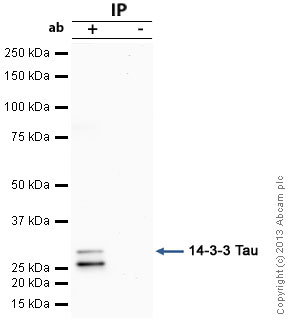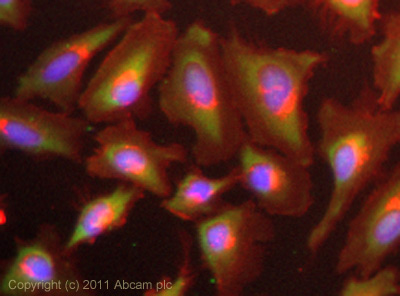Anti-14-3-3 Tau antibody [3B9]
| Name | Anti-14-3-3 Tau antibody [3B9] |
|---|---|
| Supplier | Abcam |
| Catalog | ab10439 |
| Prices | $391.00 |
| Sizes | 100 µg |
| Host | Mouse |
| Clonality | Monoclonal |
| Isotype | IgG1 |
| Clone | 3B9 |
| Applications | FC IP WB IHC-P ICC/IF ICC/IF |
| Species Reactivities | Mouse, Rat, Bovine, Human |
| Antigen | Recombinant full length protein |
| Description | Mouse Monoclonal |
| Gene | YWHAQ |
| Conjugate | Unconjugated |
| Supplier Page | Shop |
Product images
Product References
14-3-3theta protects against neurotoxicity in a cellular Parkinson's disease - 14-3-3theta protects against neurotoxicity in a cellular Parkinson's disease
Slone SR, Lesort M, Yacoubian TA. PLoS One. 2011;6(7):e21720.
Brainstem deficiency of the 14-3-3 regulator of serotonin synthesis: a proteomics - Brainstem deficiency of the 14-3-3 regulator of serotonin synthesis: a proteomics
Broadbelt KG, Rivera KD, Paterson DS, Duncan JR, Trachtenberg FL, Paulo JA, Stapels MD, Borenstein NS, Belliveau RA, Haas EA, Stanley C, Krous HF, Steen H, Kinney HC. Mol Cell Proteomics. 2012 Jan;11(1):M111.009530.
Quantitative protein expression profiling of 14-3-3 isoforms in human renal - Quantitative protein expression profiling of 14-3-3 isoforms in human renal
Liang S, Xu Y, Shen G, Liu Q, Zhao X, Xu Z, Xie X, Gong F, Li R, Wei Y. Electrophoresis. 2009 Dec;30(23):4152-62.
14-3-3zeta/tau heterodimers regulate Slingshot activity in migrating - 14-3-3zeta/tau heterodimers regulate Slingshot activity in migrating
Kligys K, Yao J, Yu D, Jones JC. Biochem Biophys Res Commun. 2009 Jun 12;383(4):450-4. doi:
Proteomic analysis of hypoxia-induced responses in the syncytialization of human - Proteomic analysis of hypoxia-induced responses in the syncytialization of human
Hu R, Jin H, Zhou S, Yang P, Li X. Placenta. 2007 May-Jun;28(5-6):399-407. Epub 2006 Nov 13.
Automated quantification tool for high-throughput proteomics using stable isotope - Automated quantification tool for high-throughput proteomics using stable isotope
Wang G, Wu WW, Pisitkun T, Hoffert JD, Knepper MA, Shen RF. Anal Chem. 2006 Aug 15;78(16):5752-61.


![All lanes : Anti-14-3-3 Tau antibody [3B9] (ab10439)Lane 1 : MDA-MB-231 (Human breast adenocarcinoma cell line) Whole Cell LysateLane 2 : HeLa (Human epithelial carcinoma cell line) Whole Cell LysateLane 3 : A431 (Human epithelial carcinoma cell line) Whole Cell LysateLane 4 : Jurkat (Human T cell lymphoblast-like cell line) Whole Cell LysateLane 5 : Y79 (Human retinoblastoma cell line) Whole Cell Lysate Lane 6 : NIH 3T3 (Mouse embryonic fibroblast cell line) Whole Cell LysateLysates/proteins at 20 µg per lane.SecondaryGoat Anti-Mouse IgG H&L (HRP) preadsorbed (ab97040) at 1/5000 dilutiondeveloped using the ECL techniquePerformed under reducing conditions.](http://www.bioprodhub.com/system/product_images/ab_products/2/sub_1/240_14-3-3-Tau-Primary-antibodies-ab10439-3.jpg)
![Overlay histogram showing SH-SY5Y cells stained with ab10439 (red line). The cells were fixed with 4% paraformaldehyde (10 min) and then permeabilized with 0.1% PBS-Tween for 20 min. The cells were then incubated in 1x PBS / 10% normal goat serum / 0.3M glycine to block non-specific protein-protein interactions followed by the antibody (ab10439, 1µg/1x106 cells) for 30 min at 22ºC. The secondary antibody used was DyLight® 488 goat anti-mouse IgG (H+L) (ab96879) at 1/500 dilution for 30 min at 22ºC. Isotype control antibody (black line) was mouse IgG1 [ICIGG1] (ab91353, 2µg/1x106 cells) used under the same conditions. Acquisition of >5,000 events was performed. This antibody gave a positive signal in SH-SY5Y cells fixed with 80% methanol (5 min)/permeabilized with 0.1% PBS-Tween for 20 min used under the same conditions.](http://www.bioprodhub.com/system/product_images/ab_products/2/sub_1/241_14-3-3-Tau-Primary-antibodies-ab10439-4.jpg)